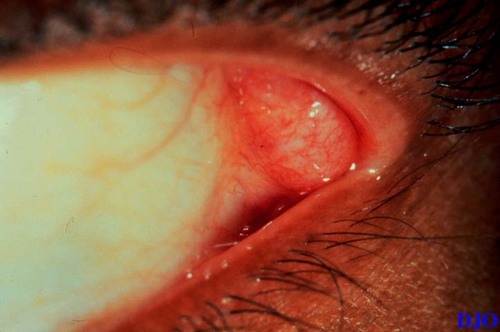General Ophthlamology Quiz 1

Figure 1
This mass was visible at the temporal aspect of the globe when the patient looked far nasally.
This mass was visible at the temporal aspect of the globe when the patient looked far nasally.
Answer: There are many entities in the differential diagnosis of a lacrimal gland mass including: sarcoidosis, orbital inflammatory pseudotumor, pleomorphic adenoma (benign mixed tumor), dermoid, lymphoid tumor, adenoid cystic carcinoma, pleomorphic adenocarcinoma (malignant mixed tumor), lacrimal gland cyst (dacryops), dacryoadenitis. Other entities are also possible.
2. What entities in the differential diagnosis are characteristically painless?
Answer: pleiomorphic adenoma, sarcoidosis, dermoid, lacrimal gland cyst, lymphoma
3. What entities in the differential diagnosis are characteristically painful?
Answer: adenoid cystic carcinoma, pleomorphic adenocarcinoma, orbital inflammatory pseudotumor, acute dacryoadenitis
4. What type of imaging studies would you obtain?
Answer: CT scan of the orbits with axial and coronal cuts will help define the nature of the lesion. Chest X-Ray would be useful to rule out sarcoidoisis and rarely tuberculosis as a possible cause of lacrimal gland enlargement. If there is suspicion of lymphoma abdominal and head CT imaging may be indicated after consultation with an internist.
5. In which types of these masses should biopsy be avoided?
Answer: Lesions suspected to be benign mixed tumors should not be biopsied because incomplete excision may result in a recurrence with possible malignant transformation. Dermoid cysts should also not be biopsied because the cyst contents can incite a severe inflammatory reaction. These types of lesions should be completely excised without rupture of the capsule.